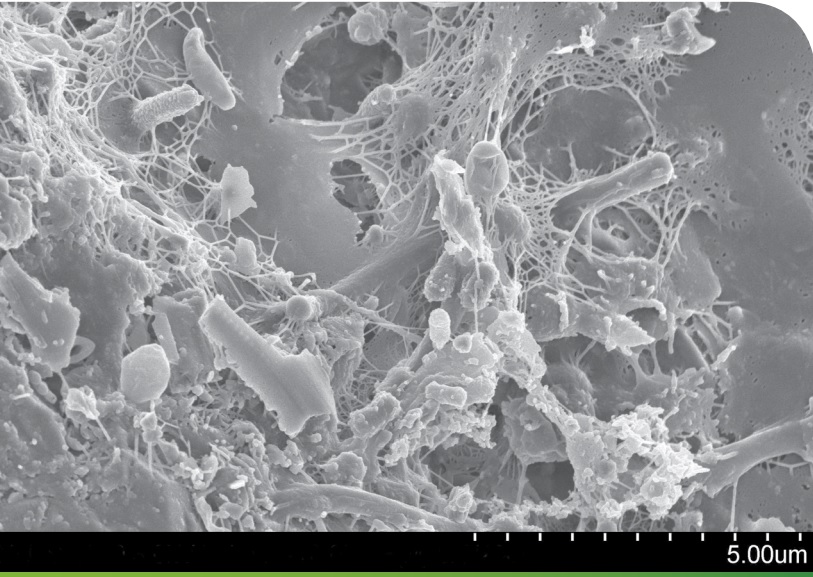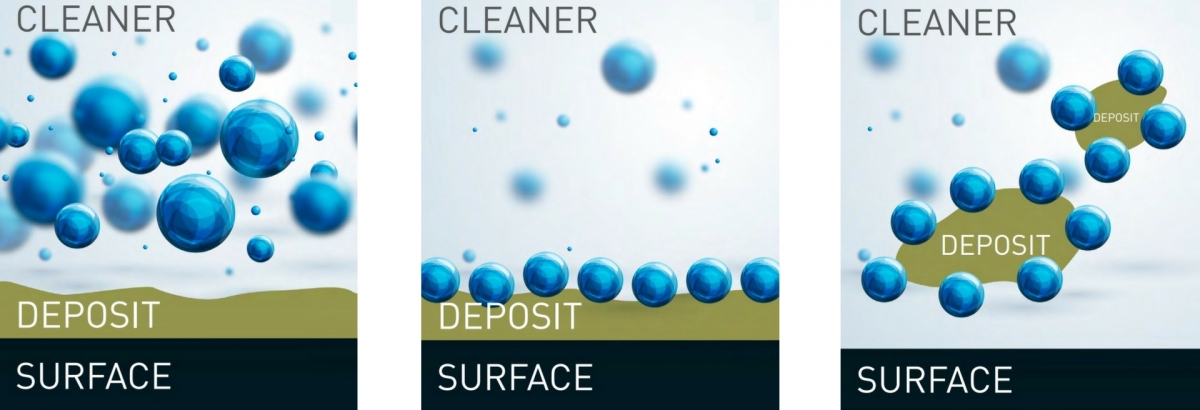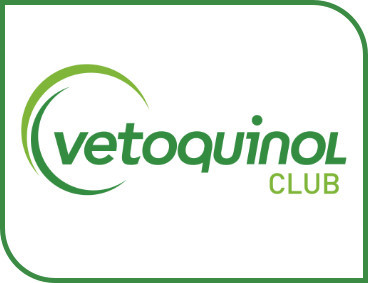Let's explore the basics of cleaning procedures in veterinary clinics.
► Selection of an appropriate cleaner
WHAT IS A BIOFILM?
Biofilm is formed when bacteria adhere to a surface and secrete a protective, sticky polymeric substance. Biofilm forms a community and can be composed of a single or multiple strains of micro-organisms (bacteria, fungi, algae, protozoa). Biofilm can be less than 1 mm thick and is often not visible to the naked eye. Biofilm provides a protective barrier that makes organisms highly resistant to disinfection. Removal of biofilm is crucial prior to disinfection of any surface. Biofilm should be removed using an alkaline cleaner.

MINERAL DEPOSITS
In addition to the formation of biofilm on surfaces, mineral deposits or scaling may be another source of surface contamination. Mineral scale will accumulate over time when using water with high levels of iron, calcium, manganese or magnesium. Hard water and urine are responsible for mineral deposits in animal care facilities. It is important to remove mineral deposits using an acidic cleaner prior to disinfection.

WHAT IS A CLEANER?
A cleaner is a blend of components that act together to penetrate, detach and break down surface deposits. The components of a cleaner may include:
- Surfactants – to facilitate penetration and breakdown of deposits.
- Sequestrants and chelating agents – to fix and hold metals and minerals.
- Emulsifiers – to help suspend soil particles in solution to facilitate rinsing.
- Foaming agents – to help the solution stick to surfaces for improved contact time and visibility.
- Acidifiers or alkalinizers – to adjust pH depending on the soiling challenge (organic or mineral).
Cleaners are an integral part of a cleaning and disinfection program. Washing with water alone does not adequately remove deposits of organic and mineral residue. The benefits of using a good cleaner include:
- Prepares surfaces for disinfection
- Reduces bacterial challenge by 90% to 99%
- Removes biofilm and mineral deposits prior to disinfection
- Reduces cleaning time by 30% to 40%
- Reduces labour costs and water consumption

SELECTION OF AN APPROPRIATE CLEANER
The primary soiling challenge in animal care facilities is organic in nature. Organic soiling requires frequent use of an alkaline cleaner.
After repeated cleaning, an accumulation of surfactant residue and water minerals may result. For this reason, periodic use of an acidic cleaner may be required.
The frequency of alkaline/acid cleaner rotation varies according to the rate of mineral deposition. An alkaline cleaner may be used four or six times for every one acidic application.
VETOQUINOL CLEANERS
► Alkaline cleaner – Biosolve™ Plus
► Acidic cleaner – Biosolve™ AFC
Next ► : Principles of disinfection

TABLE OF CONTENTS
1 ► PRINCIPLES OF CLEANING
Biofilm
Mineral deposits
What is a cleaner?
Selection of an appropriate cleaner
2 ► PRINCIPLES OF DISINFECTION
Sensitivity to disinfectants
All disinfectants are not created equally
3 ► CLEANING AND DISINFECTION STEPS
Removal of organic material
Cleaner application
Disinfection
4 ► CLEANING AND DISINFECTION STEPS FOR ANIMAL HOUSING
Runs and kennels
Cages
Large animal stalls
Calf crates
5 ► RISK ZONES WITHIN THE CLINIC
Low risk
Intermediate risk
High risk
6 ► APPLICATION METHODS
Spraying versus foaming
Equipment
Dedication of equipment by risk zone
Footwear disinfection
7 ► VETOQUINOL CLEANING AND DISINFECTION PRODUCTS
Vetoquinol Cleaners
Biosolve™ Plus
Biosolve™ AFC
Vetoquinol Disinfectants
Virkon®
BioSentry® 904
Clinicide
8 ► FREQUENTLY ASKED QUESTIONS
9 ► BIOSECURITY REFERENCES
QUIZ ► TEST YOUR KNOWLEDGE
Vetocontact
Access restricted to veterinarians


